This year, Altaf is running for re-election to Headington Ward, and Roz for Quarry & Risinghurst ward.
Click through to see Altaf’s and Roz’s leaflets for the 2024 City Council election.
Complete the survey online here
This year half the seats on the Oxford City Council are up for election. Councillor Chris Smowton was first elected last year and is up for re-election in Headington Ward, while Andrew Steele is campaigning to join our dedicated Lib Dem colleague Roz Smith as the second councillor for Quarry & Risinghurst ward.
You can see our campaign launch leaflets below:
A few applications in the neighbourhood this week:
One very important planning application landed this week: an application to redevelop the London Road Co-Operative store to include a hotel over the top.
Other applications landing this week:
Looking for the main residents’ survey? See the post below!
The Headington Councillors have surveyed over a thousand households and received over 300 responses about the County’s proposed Low-Traffic Neighbourhood (LTN) scheme for Headington Quarry. Surveying for Headington Ward is now beginning and similar detailed work there will follow soon.
We received many suggestions to vary the County’s current design proposals. In this survey we want to find out which of these variations are most popular. Note this is the Headington Lib Dems trying to get an initial impression of people’s views, not the County Council’s formal consultation process, which is currently expected to happen later this year.
Please view the information and maps below, then complete the survey here.
In this survey we compare a few variations, with details and maps shown below: the baseline (do nothing), the County’s current plan, the current plan without Gladstone/Pitts or without Wharton/St Leonard’s, the Quarry Hollow bollard alone, and a partial Quarry Hollow control that only prevents through traffic on Margaret Road and Quarry Hollow, leaving Quarry Road unaffected. We also ask about an alternative to any bollards in the Quarry itself: closing the Quarry ring-road junction.
In all the maps below, a red spot represents a lockable bollard that can be passed by bikes, wheelchairs and anything else of similar size, but not cars and larger vehicles. The red line at the top of Margaret Road represents a partial block at the Quarry Hollow / Quarry Road junction, which is pictured in detail below to clearly show that it splits the crossroads into two through roads:

All of the LTN designs below are trying to achieve four main aims:
The options presented below represent different compromises between those goals.
Self-explanatory I hope! With this option nothing at all would change.
The County’s current plan for the Quarry LTN, pictured below, features 5 bollards (unlockable to allow emergency access): a main bollard at the Quarry Hollow / High Street junction preventing through car traffic between the by-pass and Windmill Road, two on Wharton and St Leonard’s Roads intended to prevent corner-cutting between London and Windmill Roads, and two on Gladstone and Pitts Roads which would require traffic from London Road to Quarry High Street to zigzag between Gladstone and Pitts Roads (aimed at discouraging using Gladstone as a cut around the A40 roundabout).
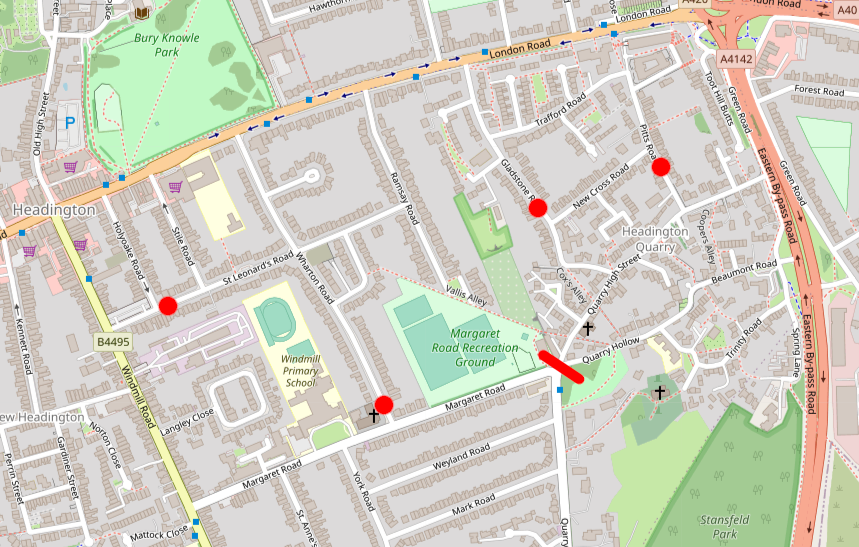
Advantages: almost all possible short-cuts through the quarry are prevented; provides the biggest incentive to avoid car travel where possible; establishes a quiet cycle route (a “quietway”) down Quarry Hollow and Margaret Road. Disadvantage: for residents making car journeys, lengthens those journeys more than other options.
This is like Option 1, but without the two bollards on Gladstone and Pitts Roads. Advantages: most possible short-cuts through the quarry are still prevented; provides a significant incentive to avoid car travel; less new traffic for New Cross and Pitts Road residents than Option 1. Disadvantages: with Gladstone Road unimpeded, there is a risk that traffic leaving the by-pass at the Quarry junction might use it to get to London Road avoiding the A40 roundabout.
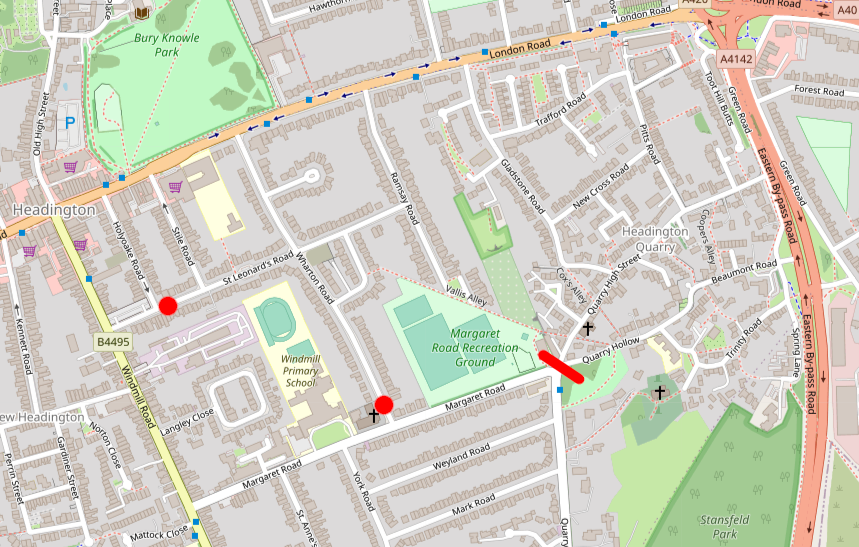
This is like Option 1 without the Wharton and St Leonard’s Road bollards. Advantages: still prevents cutting from the Quarry ring-road junction to Windmill Road; less journey lengthening for some residents than Option 1. Disadvantages: as Option 1, but gives a weaker incentive to avoid car travel, and this version does nothing to address corner-cutting between London and Windmill Roads.
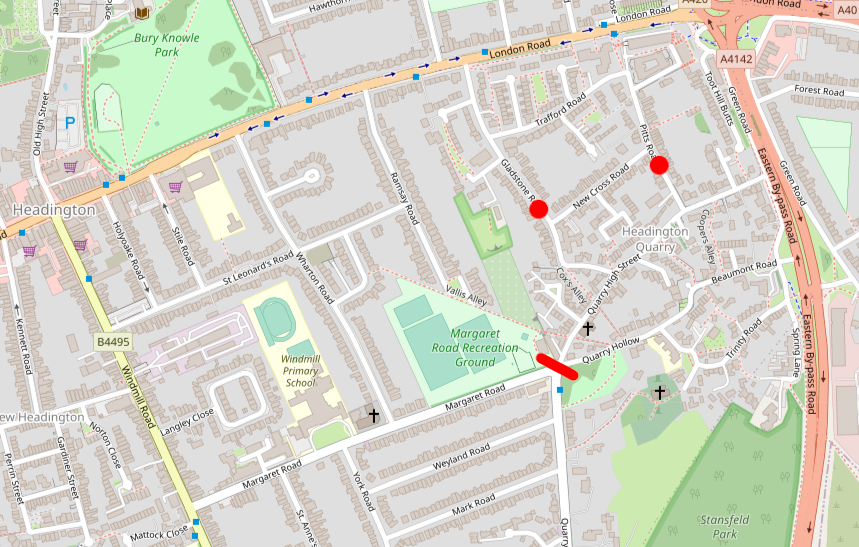
This is like options 2 and 3 combined.
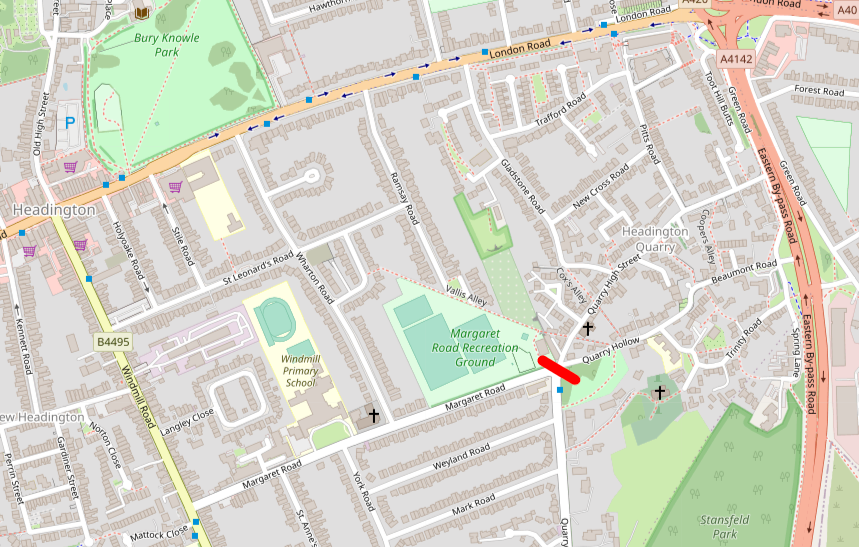
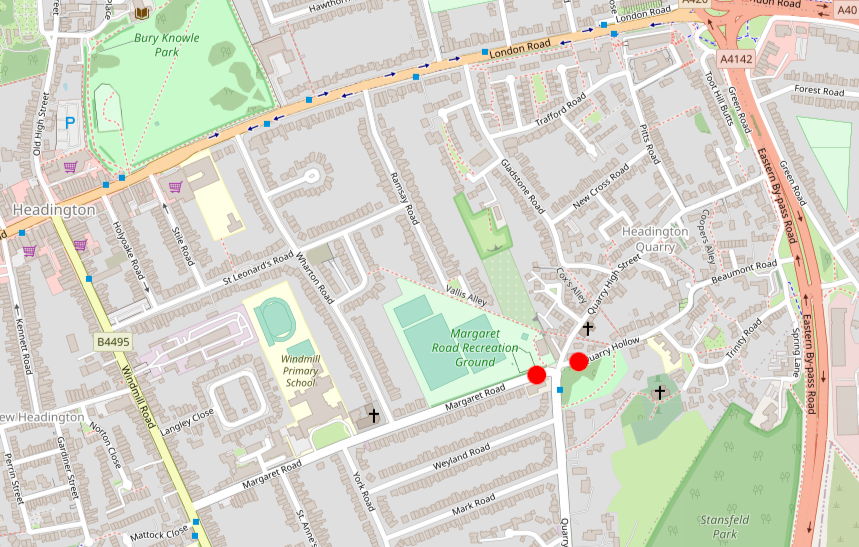
This is like Option 4, but instead of preventing all flow from Quarry High Street to Quarry Road, only Quarry Hollow and Margaret Road are blocked to car traffic. Advantages: still establishes a quiet cycle route through Quarry Hollow and Margaret Road; provides some disincentive to cut through from the Quarry by-pass junction to Windmill Road as this would require a more indirect route than at present. Disadvantages: as Option 4, but with a still weaker incentive against car travel; at busy times cutting through the quarry would still be quite likely.
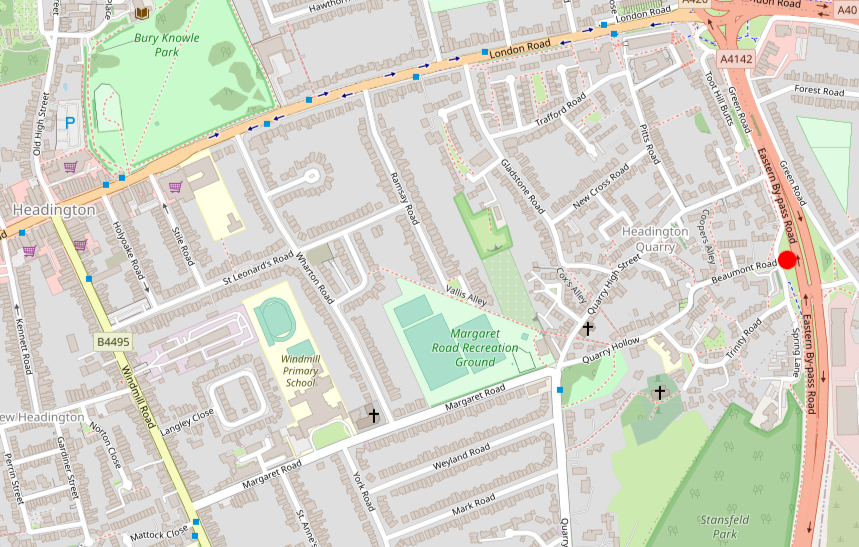
As an alternative to any bollards in the Quarry, simply close the bypass junction at the top of Beaumont Road. Advantages: prevents any cut-through traffic relating to the by-pass; avoids any journey lengthening related to non-bypass destinations. Disadvantages: provides no incentive against car travel for non-bypass destinations; as with options 3, 4 and 5 corner-cutting between London and Windmill roads is unaddressed.
The base map used to illustrate the LTN possibilities in this article are taken from OpenStreetMap. The base map is copyright © OpenStreetMap contributors.
Complete the survey here
Below we include extra detail regarding the Low-Traffic Neighbourhood (LTN) plans, showing the latest proposed locations of vehicle filters (bollards or similar allowing bikes and scooters but not cars to pass). If you have particular comments regarding these specifics (as opposed to generally favouring or opposing the concept, which is covered on the survey above), please get in touch at headington@oxonlibdems.uk.
Note that throughout, all properties are reachable by car, but the access route to a particular house may change as a result of the proposed filters. The filter shown at the junction of Quarry High Street and Quarry Hollow allows traffic to pass between these two roads, but not between them and Quarry or Margaret Roads. Note that the filters on Gladstone Road and Pitts Road are currently designed to allow a chicane route out of Quarry going Quarry High Street -> Gladstone Road -> New Cross Road -> Pitts Road -> Trafford Road -> Gladstone Road -> London Road. This is a compromise between blocking that route and compelling traffic to exit the Quarry via the bypass on the one hand, and leaving Gladstone Road unblocked and inviting its use as a cut-through on the other.
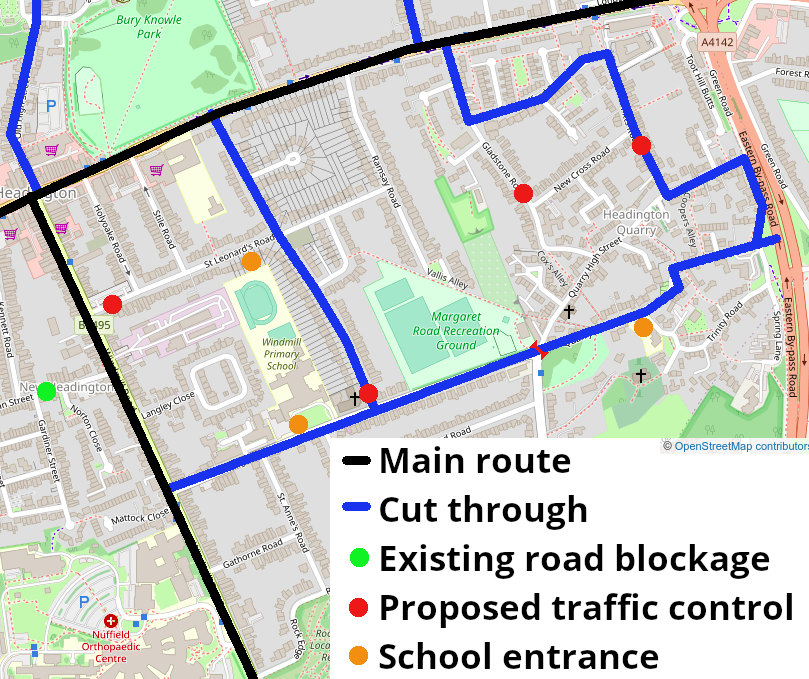
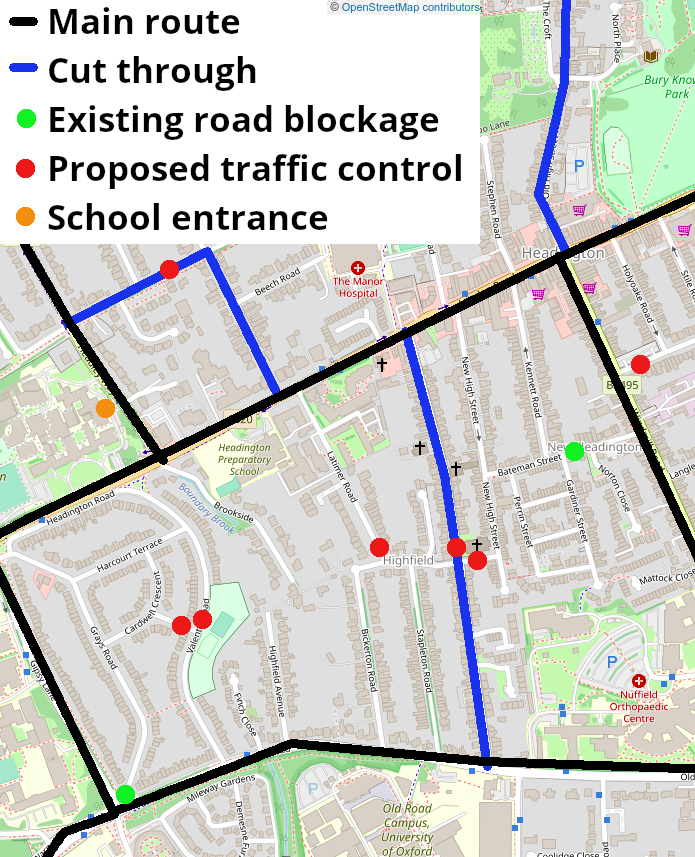
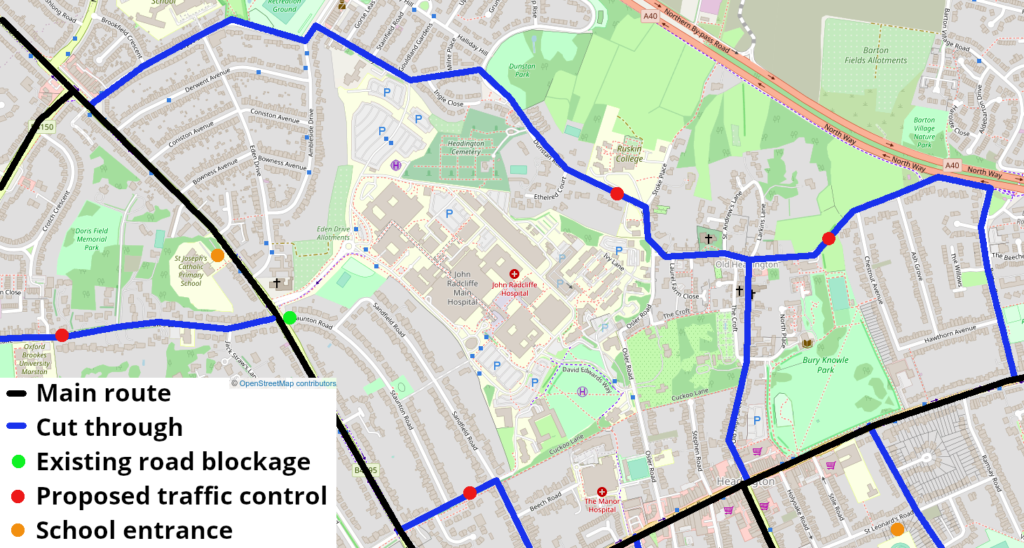
Five applications this week: